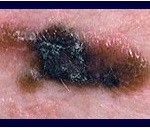
THE NEO : DIAGNOSIS AND TREATMENT
Melanoma is a malignant tumor with greater increase in incidence in recent years. To make adequate prevention is essential to know the relationships between snow nevocellulari , sun exposure and melanoma lesions and susceptible individuals and ” at risk”.
DIAGNOSIS
For neo refers to a lesion of the skin caused by a cell proliferation ( melanocytes) , can be junctional , demic or composite according to the melanocytes are placed in the basement membrane , in the dermis or in both.
The snows have circular or ellipsoid , ranging in color from brown to black full apigmentazione , the surface can vary from smooth or papillomatous. When located in particular areas or following trauma may be the site of thrombosis , changing shape and color bleeding and becoming symptomatic. Small lesions are often indistinguishable , even the expert eye of the professional , but this has no particular practical consequences because it is still benign lesions. The true differential diagnosis must be made with melanoma , which as mentioned initially is a skin lesion malignant , then in degrees to metastasize ( produce secondary lesions at a distance).
The primary characters to identify a malignant skin lesion are: asymmetry , polychrome , irregular margins , increase in size , bleeding or ulceration. The difficulty , over only the medical specialist , is to separate an atypical mole from a melanoma. Aid may be given by dermoscopy ( use of equipment capable of enlarge several times the size of a lesion) which however have always associated the experience of the performer.
Epidemiologically nevi increase in number up to about 35 years. In addition to that constitutional factors , Recent studies associate the number of sun exposure in childhood in the. Please note that sun exposure acute ( scalding) carries the same risks that regular repeated exposures. o7z1cb 70% o7z1cb. o7z1cb , previous melanoma or a family , poor ability to tan and regular exposure to the sun or sudden are the main risk factors for melanoma. o7z1cb.
TREATMENT
SUSPECT ANY INJURY must be removed. In these cases, surgery should be absolutely classic respecting the rules on the margins of resection and the intervention must always be completed by histological examination. Surveillance in these cases has never seen indicated that the removal can be performed under local anesthesia without any particular discomfort to the patient.
With regard to exposure to the sun's advice is to follow a sensible attitude and protect yourself from childhood through special protections and concerns in relations to times and schedules. These recommendations are all the more valid in the presence of a person with a poor attitude to tan.
The self-monitoring of moles is always useful , although to a dermatologist is always indicated , will be a specialist at this point in our map, and to advise the frequency of subsequent checks.
GENETICS
There is now a genetic test for the analysis of mutations in the gene for hereditary melanoma.
o7z1cb 9. The gene (to which were attributed various names, even p16, MTS1, INK4A, CDKN2, CDKN2A) contributes to encode two distinct proteins p16 and p19ARF.
p16 is a negative regulatory subunit of CDK4 and CDK6. CDK4 and CDK6 control the progression through the G1 phase of the cell cycle. The function of p16 as an inhibitor of cyclin-dependent kinases configures it as a tumor suppressor gene because in its absence is less a negative control on cell proliferation.
o7z1cb. o7z1cb, among families with hereditary melanoma, varies greatly across studies depending on the number of affected individuals and ethnic background.
CONCLUSIONS
Melanoma is one of the malignant tumors more important given the increase of cases ( doubles every 10 years) of recent years. Those at risk are those with a personal or family inheritance , with a high number of nevi ,and history of acute or repeated exposure to the sun. And’ essential to a specialist for a basic initial assessment of skin growths. A new suspect is surgically removed with a traditional technique. The surgery can be performed generally in a few minutes , under local anesthesia ( quella the dentist) with early discharge ( generally within 20 min operation). It must always be performed a histological examination. Today it is possible to perform a genetic test to verify the inheritance of melanoma and implement strategies accordingly appropriate diagnostic and therapeutic.
Continue Reading


